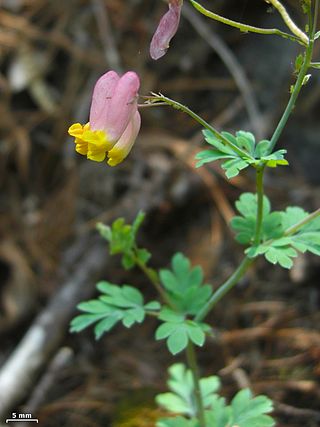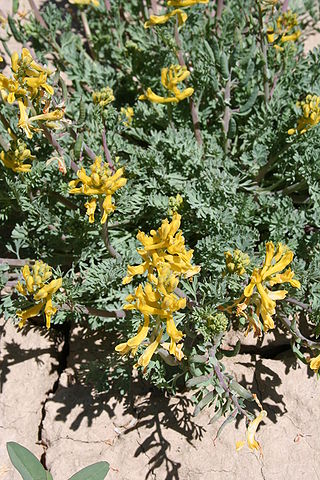
The Papaveraceae, informally known as the poppy family, are an economically important family of about 42 genera and approximately 775 known species of flowering plants in the order Ranunculales. The family is cosmopolitan, occurring in temperate and subtropical climates like Eastern Asia as well as California in North America. It is almost unknown in the tropics. Most are herbaceous plants, but a few are shrubs and small trees. The family currently includes two groups that have been considered to be separate families: Fumariaceae and Pteridophyllaceae. Papaver is the classical name for poppy in Latin.

Corydalis is a genus of about 540 species of annual and perennial herbaceous plants in the family Papaveraceae, native to the temperate Northern Hemisphere and the high mountains of tropical eastern Africa. They are most diverse in China and the Himalayas, with at least 357 species in China.

Bulbocapnine is an alkaloid found in Corydalis and Dicentra, genera of the plant family Fumariaceae which have caused the fatal poisoning of sheep and cattle. It has been shown to act as an acetylcholinesterase inhibitor, and inhibits biosynthesis of dopamine via inhibition of the enzyme tyrosine hydroxylase. Like apomorphine, it is reported to be an inhibitor of amyloid beta protein (Aβ) fiber formation, whose presence is a hallmark of Alzheimer's disease (AD). Bulbocapnine is thus a potential therapeutic under the amyloid hypothesis. According to the Dorlands Medical Dictionary, it "inhibits the reflex and motor activities of striated muscle. It has been used in the treatment of muscular tremors and vestibular nystagmus".

Corydalis flavula is an herbaceous perennial plant native to the eastern United States. Its natural habitat is open woods and slopes.

Capnoides sempervirens, the harlequin corydalis, rock harlequin, pale corydalis or pink corydalis, is an annual or biennial plant native to rocky woodland and burned or disturbed places in northern North America. Capnoides sempervirens is the only species in the genus Capnoides.

Pseudofumaria lutea, the yellow corydalis or rock fumewort, is a short-lived perennial plant in the poppy family Papaveraceae. It is native to the southern foothills of the south-western and central Alps of Italy and Switzerland, but widely introduced elsewhere.

Corydalis aurea is a flowering plant in the poppy family (Papaveraceae), native to North America. A winter annual, it can be found in such areas as the sagebrush steppe.

The Circumboreal Region in phytogeography is a floristic region within the Holarctic Kingdom in Eurasia and North America, as delineated by such geobotanists as Josias Braun-Blanquet and Armen Takhtajan.

Corydalis solida, fumewort or bird-in-a-bush, is a species of flowering plant in the family Papaveraceae, native to moist, shady habitats in northern Europe and Asia. Growing to 25 cm (10 in), it is a spring ephemeral, with foliage that appears in spring and dies down to its tuberous rootstock in summer. It is cultivated for its deeply divided, ferny leaves and narrow, long-spurred flowers which appear in spring. The flowers show color variation, and may be mauve, purple, red, or white.

Opawskie Mountains Landscape Park is a protected area in the Opawskie Mountains in south-western Poland, established in 1988, covering an area of 49.03 square kilometres (18.93 sq mi).

Nantenine is an alkaloid found in the plant Nandina domestica as well as some Corydalis species. It is an antagonist of both the α1-adrenergic receptor and the serotonin 5-HT2A receptor, and blocks both the behavioral and physiological effects of MDMA in animals.

Corydalis nobilis, the Siberian corydalis, is a perennial plant native to Siberia, Xinjiang and Kazakhstan. It was introduced to Europe by Linnaeus, who had asked his friend Erich Laxmann for seeds of Lamprocapnos spectabilis, but was sent seeds of C. nobilis instead. Both Lamprocampnos and Corydalis are members of the family Papaveraceae, with seeds having an attached elaiosome that makes them attractive to ants, which disperse the seeds.

Bažantnice u Pracejovic is a nature reserve near Strakonice in the South Bohemian Region of the Czech Republic.

Corydaline is an acetylcholinesterase inhibitor isolated from Corydalis yanhusuo.

Corynoline is an acetylcholinesterase inhibitor isolated from Corydalis incisa.

Corydalis caucasica is a species of flowering plant in the poppy family Papaveraceae, native to the Caucasus and northern Turkey.

Corydalis pumila is a species of plant in the family Papaveraceae. It is found in Central Europe and has a small, fragmented distribution. In Poland, it is a rare species found only in the western part of the country. It grows mainly in fertile deciduous forests, rarely in cemeteries and parks. The aboveground shoot develops only for two months in early spring. As a very rare species losing its habitats, it is subject to legal protection in Poland.

















